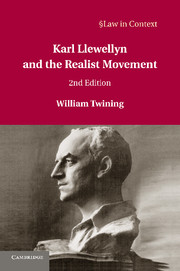Book contents
- Frontmatter
- Contents
- Foreword
- Preface
- Postscript
- Acknowledgements
- Abbreviations
- Part I The Rise of the Realist Movement 1870–1931
- Part II The Life and Work of Karl Llewellyn: A Case Study
- 6 The Man
- 7 Two Early Works
- 8 The Cheyenne Way
- 9 Law in Our Society
- 10 The Common Law Tradition
- 11 The Genesis of the Uniform Commercial Code
- 12 The Jurisprudence of the Uniform Commercial Code
- 13 Miscellaneous Writings
- 14 The Significance of Llewellyn: An Assessment
- Part III Conclusion
- Appendices
12 - The Jurisprudence of the Uniform Commercial Code
from Part II - The Life and Work of Karl Llewellyn: A Case Study
Published online by Cambridge University Press: 05 December 2012
- Frontmatter
- Contents
- Foreword
- Preface
- Postscript
- Acknowledgements
- Abbreviations
- Part I The Rise of the Realist Movement 1870–1931
- Part II The Life and Work of Karl Llewellyn: A Case Study
- 6 The Man
- 7 Two Early Works
- 8 The Cheyenne Way
- 9 Law in Our Society
- 10 The Common Law Tradition
- 11 The Genesis of the Uniform Commercial Code
- 12 The Jurisprudence of the Uniform Commercial Code
- 13 Miscellaneous Writings
- 14 The Significance of Llewellyn: An Assessment
- Part III Conclusion
- Appendices
Summary
This brief study of the history and institutional setting of the Code shows that the relationship between its basic theory and the finished product was not simply one of conception and execution. The project was neither conceived nor planned a priori. Schnader's idea was stimulated by his concern, as President of the NCC, that the institution was not achieving its aims. Commercial law appeared to be the one area in which there was a consistent demand for uniformity. The ALI and the NCC consisted of leading lawyers who could be expected to be suspicious of innovation. The existing Uniform Commercial Acts and the working procedures adopted for the Restatement project were the obvious starting-points for discussion of scope, substance and working procedures. From the outset it was clear that if a code was to have a good chance of being enacted it would have to satisfy three principal groups of people: the lawyers in the sponsoring organizations, the more organized pressure groups outside the legislatures, and the legislators themselves. An a priori conception of an ideal commercial code would have needed considerable modification to survive the processes which culminated in enactment in a multiplicity of legislatures. Llewellyn never articulated such a conception. In short, the desirable and the feasible were not sharply distinguished.
This, then, was the context of Llewellyn's activities. What he considered desirable was set in a framework of assumptions largely fixed by a particular situation.
- Type
- Chapter
- Information
- Karl Llewellyn and the Realist Movement , pp. 302 - 340Publisher: Cambridge University PressPrint publication year: 2012



